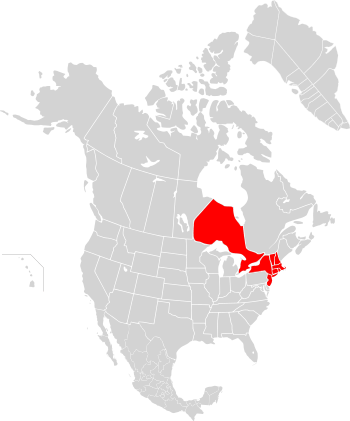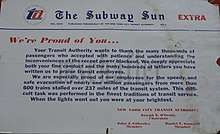Northeast blackout of 1965
The northeast blackout of 1965 was a significant disruption in the supply of electricity on Tuesday, November 9, 1965, affecting parts of Ontario in Canada and Connecticut, Massachusetts, New Hampshire, New Jersey, New York, Rhode Island, Pennsylvania, and Vermont in the United States. Over 30 million people and 80,000 square miles (207,000 km2) were left without electricity for up to 13 hours.[1]

Cause
The cause of the failure was the setting of a protective relay on one of the transmission lines from the Sir Adam Beck Hydroelectric Power Station No. 2 in Queenston, Ontario, near Niagara Falls. The safety relay was set to trip if other protective equipment deeper within the Ontario Hydro system failed to operate properly. On a particularly cold November evening, power demands for heating, lighting, and cooking were pushing the electrical system to near its peak capacity. Transmission lines heading into southern Ontario were heavily loaded. The safety relay had been misprogrammed, and it did what it had been asked to do: to disconnect under the loads it perceived. As a result, at 5:16 p.m. Eastern Time, a small variation of power originating from the Robert Moses generating plant in Lewiston, New York caused the relay to trip, disabling a main power line heading into Southern Ontario. Instantly, the power that was flowing on the tripped line transferred to the other lines, causing them to become overloaded. Their own protective relays, which are also designed to protect the lines from overload, tripped, isolating Beck Station from all of southern Ontario.[2]
With nowhere else to go, the excess power from Beck Station then flowed east, over the interconnected lines into New York state, overloading them as well, and isolating the power generated in the Niagara region from the rest of the interconnected grid. The Beck generators, with no outlet for their power, were automatically shut down to prevent damage. The Robert Moses Niagara Power Plant continued to generate power, which supplied Niagara Mohawk Power Corporation customers in the metropolitan areas of Buffalo and Niagara Falls, New York. These areas ended up being isolated from the rest of the Northeast power grid and remained powered up. The Niagara Mohawk Western NY Huntley (Buffalo) and Dunkirk steam plants were knocked offline.[3] Within five minutes, the power distribution system in the Northeast was in chaos as the effects of overloads and the subsequent loss of generating capacity cascaded through the network, breaking the grid into "islands". Station after station experienced load imbalances and automatically shut down. The affected power areas were the Ontario Hydro System, St Lawrence-Oswego, Upstate New York, and New England. With only limited electrical connection southwards, power to the southern states was not affected. The only part of the Ontario Hydro System not affected was the Fort Erie area next to Buffalo, which was still powered by older 25 Hz generators. Residents in Fort Erie were able to pick up a TV broadcast from New York, where a local backup generator was being used for transmission purposes.
Radio
An aircheck[4] of New York City radio station WABC from November 9, 1965 reveals disc jockey Dan Ingram doing a segment of his afternoon drive time show, during which he noted that a record he was playing (Jonathan King's "Everyone's Gone to the Moon") sounded slow, as did the subsequent jingles played during a commercial break. Ingram quipped that the King record "was in the key of R." The station's music playback equipment used AC motors whose speed was dependent on the frequency of the powerline, normally 60 Hz. Comparisons of segments of the hit songs played at the time of the broadcast, minutes before the blackout happened, in this aircheck, as compared to the same song recordings played at normal speed reveal that approximately six minutes before blackout the line frequency was 56 Hz, and just two minutes before the blackout that frequency dropped to 51 Hz.[5] As Si Zentner's recording of "(Up a) Lazy River" plays in the background – again at a slower-than-normal tempo – Ingram mentions that the lights in the studio are dimming, then suggests that the electricity itself is slowing down, adding, "I didn't know that could happen". When the station's Action Central News report comes on at 5:25 pm ET, the staff remains oblivious to the impending blackout. The lead story is still Roger Allen LaPorte's self-immolation at United Nations Headquarters earlier that day to protest American military involvement in the Vietnam War; a taped sound bite with the attending physician plays noticeably slower and lower than usual. The newscast gradually fizzles out as power is lost by the time newscaster Bill Rice starts delivering the second story about New Jersey Senator Clifford P. Case's comments on his home state's recent gubernatorial election.
Unaffected areas
Some areas within the affected region were not blacked out. Municipal utilities in Hartford, Connecticut; Braintree, Holyoke, and Taunton, Massachusetts; and Fairport, Greenport, and Walden, New York had their own power plants, which operators disconnected from the grid and which were able to sustain local loads,[6] though some areas lost power for at least a few hours. In New York City, Staten Island and parts of Brooklyn were spared when Con Edison disconnected its Arthur Kill Generating Station from the grid. Rochdale, Queens was also unaffected as it had its own power plant.
Effect and aftermath
New York City was dark by 5:27 p.m. The blackout was not universal in the city; some neighborhoods never lost power. Also, some suburban areas, including Bergen County, New Jersey - served by PSE&G - did not lose power. Most of the television stations in the New York metro area were forced off the air, as well as about half the FM radio stations, as their common transmitter tower atop the Empire State Building lost power.
Fortunately, a bright full moon lit up the cloudless sky over the entire blackout area,[7] providing some aid for the millions who were suddenly plunged into darkness.
Most telephones remained operational, the telephone exchanges powered by emergency generators. However, not all emergency generators functioned as desired. The generator at Upstate Medical Center in Syracuse failed to start, creating a serious crisis and forcing surgeons to complete operations in progress by flashlight.
Power restoration was uneven. Most generators had no auxiliary power to use for startup. Parts of Brooklyn were repowered by 11:00pm, the rest of the borough by midnight. However, the entire city was not returned to normal power supply until nearly 7:00 a.m. the next day, November 10.
Power in western New York was restored in a few hours, thanks to the Genesee River-powered generating plant in Rochester, which stayed online throughout the blackout. Like starting a car, to start or restart a generator requires power for a starter motor (see black start). The availability of this hydroelectric power was crucial; it was used to restart dead generators, which then could provide power to restart other generators, in a cascading process which required much switching by engineers at the various plants.
The Mount Weather Emergency Operations Center saw the first full-scale activation of the facility during the blackout.[8][9]
The New York Times was able to produce a ten-page edition for November 10, using the printing presses of a nearby paper that was not affected, the Newark Evening News.[10] The front page showed a photograph of the city skyline with its lights all out.[11]
Following the blackout, measures were undertaken to try to prevent a repetition. Reliability councils were formed to establish standards, share information, and improve coordination amongst electricity providers. Ten councils were created covering the four networks of the North American Interconnected Systems. The Northeast Power Coordinating Council covered the area affected by the 1965 blackout.
The task force that investigated the blackout found that a lack of voltage and current monitoring was a contributing factor to the blackout, and recommended improvements.
The Electric Power Research Institute helped the electric power industry develop new metering and monitoring equipment and systems, which have become the modern SCADA systems in use today.

In contrast to the wave of looting and other incidents that took place during the 1977 New York City blackout, only five reports of looting were made in New York City after the 1965 blackout. It was said to be the lowest amount of crime on any night in the city's history since records were first kept.[12] However more than 800000 riders were trapped in the subway.
Reports about an alleged baby boom that followed the blackout nine months later are considered unsubstantiated.[13]
Immediately following the outage, R&B group The Ad Libs released a single about the incident, titled "New York In the Dark", on the AGP Records label. It included lines such as "The people they were frantic, although they didn't panic, they kept on singing songs, until the lights came on again" and "And the moon was shinin' through that 'ole silver silver linin'".
See also
References
- Burke, James (1985-12-17). "The Trigger Effect". Connections. Series 1. Episode 1. Event occurs at 15:30. BBC.
Over an area of 80 million square miles, 30 million people were now in darkness.
- Report of The Northeast Power co-ordinating Council (NPCC)
- Buffalo Evening News, November 10, 1965
- "MP3 of the broadcast as the blackout happened". WABC (AM) Music Radio 77. November 9, 1965. Retrieved December 3, 2010.
- "Hear WABC DJ in NYC Talk Live On Air During Famous 1965 Northeast Blackout". That Eric Alper. October 16, 2015. Retrieved October 17, 2015.
- "Providing Blackout Lights". Time Magazine. December 10, 1965.
- http://www.fullmoon.info/en/fullmoon-calendar/1965.html
- "Mount Weather / High Point Special Facility (SF) / Western Virginia Office of Controlled Conflict Operations - United States Nuclear Forces". fas.org. Retrieved 2016-08-27.
- Keeny, L. Douglas (2002). The Doomsday Scenario. St. Paul, Minnesota: MBI Publishing Company. pp. 16. ISBN 0-7603-1313-X.
- "The New York Times: Our History / 1965". nytco.com. Retrieved 2016-12-13.
- "Front page". The New York Times. November 10, 1965.
- Frum, David (2000). How We Got Here: The '70s. New York, New York: Basic Books. p. 14. ISBN 0-465-04195-7.
- "FACT CHECK: Blackout Baby Boom". Snopes.com. Retrieved 2018-10-26.
Further reading
- Cave, Damien (October 15, 2001). "Imaginary infants as beacons of hope". Salon.com.
- Nye, David E. (2010). When the Lights Went Out: A History of Blackouts in America. Cambridge, MA: MIT Press. ISBN 978-0-262-01374-1.
- Schewe, Phillip (2006). The Grid: A Journey Through the Heart of Our Electrified World. Washington, DC: Joseph Henry Press. ISBN 978-0-309-10260-5.
- Sitts, George (December 1965). "Radio Pierces The Great Blackout". Broadcast Engineering. Archived from the original on 2010-05-09.
External links
- Summers, Randy. "Memoirs of the 1965 Blackout". MemoryArchive. Archived from the original on 2014-11-11.
- The Trigger Effect. Connections. 1978. The first episode of this BBC documentary series explained and re-enacted parts of the blackout.
- The Blackout of 1965 (NBC-TV coverage). YouTube.
- "The 'Great Northeastern Blackout' of 1965". CBC Digital Archives.